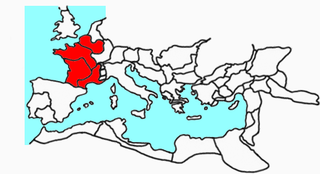
Gallienus, also known as Gallien, was Roman Emperor with his father Valerian from 22 October 253 to spring 260 and alone from spring 260 to September 268. He ruled during the Crisis of the Third Century that nearly caused the collapse of the empire. While he won a number of military victories, he was unable to prevent the secession of important provinces. His 15-year reign was the longest since the 19-year rule of Caracalla.
The 270s decade ran from January 1, 270, to December 31, 279.
The 260s decade ran from January 1, 260, to December 31, 269.

Aurelian was Roman Emperor from 270 to 275. Born in humble circumstances, he rose through the military ranks to become emperor. During his reign, he defeated the Alamanni after a devastating war. He also defeated the Goths, Vandals, Juthungi, Sarmatians, and Carpi. Aurelian restored the Empire's eastern provinces after his conquest of the Palmyrene Empire in 273. The following year he conquered the Gallic Empire in the west, reuniting the Empire in its entirety. He was also responsible for the construction of the Aurelian Walls in Rome, and the abandonment of the province of Dacia.

Year 268 (CCLXVIII) was a leap year starting on Wednesday of the Julian calendar. At the time, it was known as the Year of the Consulship of Paternus and Egnatius. The denomination 268 for this year has been used since the early medieval period, when the Anno Domini calendar era became the prevalent method in Europe for naming years.

Claudius Gothicus, also known as Claudius II, was Roman emperor from 268 to 270. During his reign he fought successfully against the Alemanni and decisively defeated the Goths at the Battle of Naissus. He died after succumbing to "pestilence", possibly the Plague of Cyprian that had ravaged the provinces of the Empire.
The Battle of Naissus was the defeat of a Gothic coalition by the Roman Empire under Emperor Gallienus near Naissus. The events around the invasion and the battle are an important part of the history of the Crisis of the Third Century.

Marcus Cassianius Latinius Postumus was a Roman commander of Batavian origin who ruled as Emperor in the West. The Roman army in Gaul threw off its allegiance to Gallienus around the year 260, and Postumus assumed the title and powers of Emperor in the provinces of Gaul, Germania, Britannia and Hispania, thereby founding what scholars have dubbed the Gallic Empire. He ruled for the better part of ten years before he was murdered by his own troops.

Titus Fulvius Iunius Macrianus, also known as Macrianus Minor, was a Roman usurper. He was the son of Fulvius Macrianus, also known as Macrianus Major.

Manius Acilius Aureolus was a Roman military commander and would-be usurper. He was one of the so-called Thirty Tyrants who populated the reign of the Emperor Gallienus. Of humble Daco-Roman origins, he was 'made' by the Emperor Gallienus and proved himself to be one of the most brilliant and innovative soldiers of the age. However, he later turned against his benefactor, and was destroyed in the political turmoil that surrounded the Emperor's assassination in a conspiracy orchestrated by his senior officers. The ancient sources which refer to Aureolus are limited and the information they do provide is often contradictory. They include the Historia Augusta, Zonaras' epitome and Zosimus' Historia Nova. His career was most recently summarised in John Bray's biography of Gallienus. The analysis of Aureolus's career given here, especially his final rebellion, is largely based on Bray.
Balista or Ballista, also known in the sources with the name of "Callistus", was one of the Thirty Tyrants of the controversial Historia Augusta, and supported the rebellion of the Macriani against Emperor Gallienus.

Lucius Julius Aurelius Septimius Vaballathus Athenodorusc. 259–74 AD) was emperor of the Palmyrene Empire centered at Palmyra in the region of Syria. He came to power as a child under his regent mother Zenobia, who led a revolt against the Roman Empire and formed the independent Palmyrene Empire.
The Gallienus usurpers were the usurpers who claimed imperial power during the reign of Gallienus. The existence of usurpers during the Crisis of the Third Century was very common, and the high number of usurpers fought by Gallienus is due to his long rule; 15 years was a long reign by the standards of the 3rd century Roman Empire.

Victoria, also known as Vitruvia, was a leader in the Roman breakaway realm known as the Gallic Empire in the late 3rd century. She was the mother of Victorinus, who ruled as Gallic Emperor until his assassination in 271. Afterwards, Victoria used her authority to stabilize the empire and select a successor.
Marcus(?) Aurelius Heraclianus was a Roman soldier who rose to the rank of Praetorian Prefect in the latter part of the reign of the Emperor Gallienus. He was a member of the cabal of senior commanders of the Imperial field army that plotted and achieved the assassination of the Emperor Gallienus. His subsequent fate is uncertain. The only ancient reference has him committing suicide, but the circumstances are unclear.
Iulius Placidianus was a Roman general of the 3rd century. He was a professional soldier who advanced his career under Gallienus and survived into the age of Claudius II and Aurelian. Placidianus was consul in the year 273 as the posterior colleague of Marcus Claudius Tacitus, the future emperor. His life presented here is largely derived from L.L. Howe’s history of the Praetorian Prefecture..






















